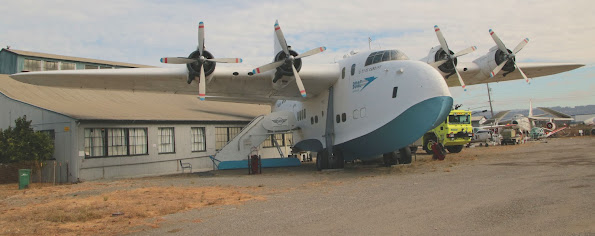Oakland is often seen as the awkward step-sister of San Francisco. Despite being the home of Jack London, Gertrude Stein, who famously remarked of Oakland, “There is no there, there”, Robert Lewis Stevenson, Joaquin Miller, Henry J. Kaiser, Bernard Maybeck, Buster Crabbe, Frank Oz, Bruce Lee, and many other famous (and infamous) people, Oakland never had the fame and adoration showered upon San Francisco. Yet, Oakland has some firsts which it can call its own. The Popsicle was invented by Oakland native Frank Epperson, Victor Bergeron claimed to have invented the Mai Tai at his Oakland bar and restaurant, and Children’s Fairyland, opened in 1950 was one of the inspirations for Disneyland. Despite having a rich history of its own, including being the terminus for the Transcontinental Railroad, even during the 1906 Earthquake, San Franciscans toasted their survival with the phrase, “Eat, Drink, and Be Merry, for tomorrow we may have to live in Oakland.”
Oakland
was an early hub for aviation. Oakland Airport was constructed and
opened in 1927, with a 7,020 foot long runway, the longest in the
world at the time. Originally constructed for the Dole Air Race from
California to Hawaii, Oakland Airport became the starting point for
the first Trans-Pacific flight to Hawaii by the
Bird of Paradise
on June 28–29, 1927, and
was
officially dedicated on September 17, 1927 by Charles Lindbergh.
Hegenberger Road in Oakland is named after Major General Albert F.
Hegenberger, who along with Brigadier General Lester J. Maitland, for
whom Maitland Drive is named, made the flight to Hawaii in the
Bird of Paradise.
In
December, the Boeing Air Transport, the predecessor to United
Airlines, made Oakland Airport its west coast home.
By
December of 1929, construction of Oakland Airport was complete with a
terminal, five hangars, a restaurant, and America’s first airport
inn. The long runway and amenities made it a hub for long distance
flight. The first flight from North America to Australia took off
from Oakland on May 31, 1928, and Amelia Earhart’s solo flight from
Hawaii in 1935 ended here on on January 12. Her ill fated second
attempt to circumnavigate the globe took off from Oakland on May 21,
1937. One off attempts were not the only long haul flights to
originate or terminate in Oakland. In the 30’s up until the
beginning of World War II both Boeing and Trans World Airlines
operated out of Oakland.
With
the beginning of World War II, Oakland Airport became a major
logistics hub for the West Coast. Proximity to the port facilities
and railroads meant that a huge amount of men and materiel were sent
out of Oakland. In 1943, Oakland Airport became Naval Air Station
Oakland and all of the commercial flights were transferred to Mills
Field (San Francisco Airport). At the end of the war, Oakland became
a reserve air field and passenger service slowly returned. By 1962,
a new airport terminal was opened with a 10,000 foot runway to
accommodate commercial jet aircraft and the original Oakland Airport
became known as North Field and now acts as an air freight, charter,
and general aviation hub.
Housed
in the hanger that once was the location of the Boeing School of
Aeronautics, is the Oakland Aviation Museum. While
not as well known as other Bay Area attractions, it offers a look at
a nearly forgotten part of Bay Area and California history.
Obviously, its focus is on the history of aviation in Oakland and
Alameda, but that is not the sole focus of the museum. The museum
contains exhibits about Amelia Earhart, Women in Aviation, the
US 8th
Air Force, Naval Aviation, and African Americans in Aviation. There
are exhibits on World Airways, Transocean Air Lines and Trans
International, later Transamerica Airlines; all three of which
operated scheduled and charter service out of Oakland.
Beyond
those exhibits, the museum also has an interesting collection of over
30
aircraft ranging
from a replica of a Wright EX to a Harrier that was used by NASA.
Included in the collection are a ¾ scale P-51 Mustang, a MIG-15, an
A-6 Intruder, an F-14 Tomcat, and an ADM 20 “Quail” cruise
missile. The highlight of the collection is the museum’s Short
Solent Flying Boat, one of only two left in existence. This
Solent, named the City of Cardiff and now in BOAC livery, made an
appearance in
Raiders of the Lost Ark
and was once owned by Howard Hughes. The museum also has a
collection of light aircraft and gliders and several aircraft engines
on static display. There are tours of the Solent and “open
cockpit” days during which the public can get a much closer look at
the aircraft on display.
The
museum is located at 8252 Earhart Road, Oakland.
For
more information including hours of operation,
admission fees, and a schedule of special events, please visit the
museum’s website at: https://www.oaklandaviationmuseum.org.
GETTING
THERE: From 414 Mason Street: Head south on Mason St toward Derby
St. Use the right lane to turn left onto Eddy St. Use the right 2
lanes to turn right onto 5th
Street. Continue onto 5th St.Use
the left 2 lanes to turn sharply left to merge onto I-80 E. Continue
on I-80 E. Take I-880 S to Hegenberger Rd in Oakland. Take exit 36
from I-880 S.
Use
the right lane to take exit 36 for Hegenberger Rd toward
Coliseum/Oakland Arpt. Follow Hegenberger Rd, CA-61 N/Doolittle Dr
and Earhart Rd to Boeing St. Use the right 2 lanes to turn right
onto Hegenberger Rd. Turn right onto CA-61 N/Doolittle Dr. Use the
2nd from the left lane to turn left onto Swan Way. Turn right onto
Earhart Rd. Turn right onto Cooke St. Turn left onto Boeing St. The museum will be on the right.
Oakland
Aviation Museum
8252
Earhart Rd, Oakland, CA 94621
